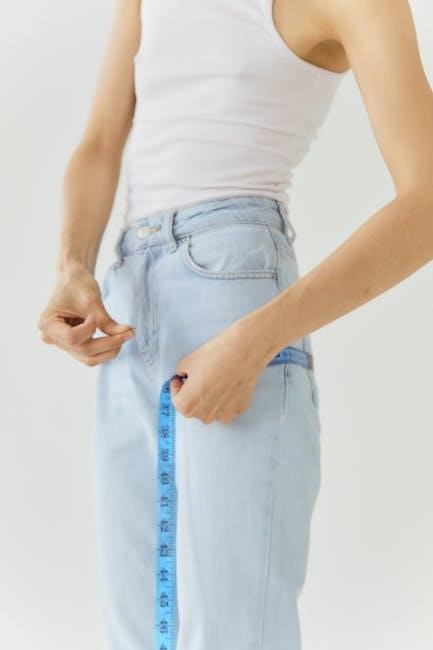
A women’s jeans size guide helps navigate the challenges of finding the perfect fit, addressing varying brand sizes and styles to ensure comfort and confidence.
Why a Size Guide is Essential
A size guide is crucial for ensuring a perfect fit, as women’s jeans sizing can vary significantly across brands and styles. It helps eliminate guesswork, reducing the likelihood of ill-fitting purchases. By providing standardized measurements, a size guide empowers shoppers to make informed decisions, whether they’re buying online or in-store. Accurate sizing ensures comfort, confidence, and a flattering appearance, making it an indispensable tool for any denim purchase.
Understanding the Importance of Proper Fit
Proper fit is essential for both comfort and confidence, as it ensures jeans sit comfortably without restricting movement. A well-fitting pair flatters the body, enhancing overall appearance. Different body types require specific fits, and understanding this ensures the right style is chosen. Whether petite, tall, or plus-size, the correct fit maximizes comfort and style, making it a cornerstone of wardrobe satisfaction and a key factor in enjoying everyday activities with ease and confidence.

Understanding Women’s Jeans Sizes
Women’s jeans sizes vary by brand and style, with options ranging from numeric to alphabetical. Understanding these systems helps in selecting the best fit for your body type.
Numeric vs. Alphabetical Sizing
Women’s jeans sizing systems vary between numeric (e.g., 24, 25) and alphabetical (e.g., S, M, L). Numeric sizing often correlates with specific measurements, offering precision, while alphabetical sizing provides a broader fit range. Numeric sizes are generally more consistent across brands, whereas alphabetical sizes can vary. Understanding these differences helps in selecting the most accurate fit for your body type and personal comfort preferences.
Plus Size vs. Regular Size: Key Differences
Plus size jeans cater to curvier figures, typically sizes 16 and above, offering a more generous fit through the hips, thighs, and waist. Regular sizes focus on a narrower silhouette, designed for smaller body types. Both styles prioritize comfort but differ in proportions. Understanding these distinctions ensures a tailored fit, whether you opt for plus or regular sizes, enhancing confidence and style.

How to Measure Your Body for Jeans
Accurate measurements are key to finding your perfect fit. Measure your waist at its narrowest point, hips at their fullest, and inseam for pant length.

Waist Measurement: Step-by-Step Guide
To measure your waist for jeans, locate the narrowest point, typically just above your belly button. Wrap a flexible tape measure evenly around your natural waistline, keeping it parallel to the floor. Ensure the tape isn’t too tight or loose. Stand up straight and relax your stomach to get an accurate reading. This measurement is crucial for determining the perfect fit and style of your jeans.
Hip Measurement: How to Get it Right
Measure your hips by wrapping a tape measure around the widest part, typically 7-9 inches below your waistline. Stand up straight and ensure the tape is level and not twisted. Keep it snug but not tight to get an accurate reading. This measurement helps determine the best fit for your jeans, ensuring comfort and a flattering silhouette. Accuracy here is key for a perfect fit.
Inseam and Outseam: What You Need to Know
The inseam is the length from the crotch to the bottom of the pant leg, while the outseam measures from the top of the waistband to the hem. To measure inseam, place the tape measure along the inside of your leg from the crotch to your ankle. For outseam, measure straight down the outside of the leg. These measurements help determine the ideal pant length for your height and style preferences, ensuring the perfect fit and look.
Jeans Size Chart: How to Read It
A jeans size chart maps measurements to sizes, helping you match your waist, hip, and inseam to the perfect fit. Always refer to the brand’s specific chart for accuracy.
Interpreting the Size Chart
Interpreting a jeans size chart involves aligning your body measurements with the corresponding size options. Charts typically list waist, hip, and inseam measurements, helping you identify your best fit. Sizes may vary across brands, so always refer to the specific brand’s chart. Measure in inches for accuracy, and use a flexible tape measure for consistency. Double-check your measurements and consider your preferred fit style when selecting your size.
Matching Your Measurements to the Chart
To find your ideal size, compare your waist, hip, and inseam measurements to the chart. Ensure you’re using a brand-specific guide, as sizing can vary. Align your waist measurement with the chart’s range, then check hip and inseam lengths for consistency. If your measurements fall between sizes, consider your preferred fit style. Some brands offer size advisors to help you match your measurements accurately for the best fit.

Understanding Different Jeans Styles
Jeans styles vary, impacting fit and comfort. Skinny, straight, and bootcut styles cater to different body types, ensuring a flattering and comfortable fit for every woman.
How Style Affects Fit
Jeans styles significantly influence fit, as different cuts cater to various body types. Skinny jeans hug curves tightly, while boyfriend styles offer a relaxed look. High-waisted designs support the waist, creating a longer torso illusion. Straight-leg and bootcut jeans balance proportions, flaring slightly at the ankle. Understanding how each style complements your silhouette ensures a tailored, comfortable, and flattering fit, making style a crucial factor in choosing the perfect pair.
Body Type and Jeans Style Compatibility
Jeans styles vary to flatter different body types. Pear-shaped women benefit from high-waisted or bootcut jeans that balance hips and thighs. Hourglass figures shine in skinny or high-waisted styles that accentuate curves. Rectangular body types can add shape with embroidered or flare jeans, while petite frames look best in cropped or straight-leg designs. Understanding your body type helps choose styles that create a balanced, flattering silhouette for ultimate comfort and confidence.
Fabric and Stretch: Impact on Sizing
Fabric type and stretch significantly influence jeans sizing. High-stretch fabrics provide flexibility, while non-stretch fabrics offer structure. Understanding fabric composition ensures a more accurate fit and comfort.
High-Stretch vs. Non-Stretch Fabrics
High-stretch fabrics, like elastane blends, offer flexibility and a snug fit, ideal for skinny or slim-fit jeans. Non-stretch fabrics, such as 100% cotton, provide structure but less flexibility, often used in straight or loose-fit styles. The choice between them impacts sizing, comfort, and the overall silhouette. High-stretch fabrics may require careful sizing to avoid over-stretching, while non-stretch fabrics maintain their shape but may feel restrictive to some wearers. Both options cater to different body types and preferences, ensuring a tailored fit.
How Fabric Choice Affects Fit
Fabric choice significantly impacts the fit of jeans, as different materials offer varying levels of stretch, structure, and comfort. High-stretch fabrics, like elastane blends, provide flexibility and contour to the body, while non-stretch fabrics, such as pure cotton, offer a more rigid, classic fit. Thicker fabrics may feel more durable but less form-fitting, whereas lightweight fabrics draping smoothly. The right fabric ensures both comfort and a flattering silhouette, tailored to personal preferences and lifestyles.
Jeans Rise: High, Mid, or Low
Jeans rise refers to the distance between the waistband and the crotch seam, determining how high or low the pants sit on the body.
Understanding Different Rise Types
High-rise jeans sit above the natural waist, offering full coverage and a retro look. Mid-rise strikes a balance, sitting just below the belly button, while low-rise rests lower, creating a trendy, modern silhouette. Each rise type caters to different body types and style preferences, ensuring comfort and confidence. Understanding these options helps in selecting the most flattering fit for your frame and fashion goals;
Choosing the Right Rise for Your Body Type
High-rise jeans are ideal for elongating legs and offering coverage, suitable for hourglass or pear-shaped bodies. Mid-rise provides a balanced fit, complementing most body types, while low-rise accents a trendy look, better for shorter torsos. Petite women may prefer high-rise for length, while those with longer torsos might opt for mid or low-rise. Consider personal style, comfort, and measurements to find the most flattering fit for your frame and fashion goals.

Inseam and Pant Length
Inseam measures the pant length from crotch to hem, while pant length determines fit and style. Accurate measurements ensure the right balance of comfort and aesthetics for any body type.
How to Measure Inseam
To measure inseam, lay the jeans flat with the front and back aligned. Place a tape measure along the crotch seam, extending it straight to the bottom of the hem. Ensure the jeans are smooth and unwrinkled for accuracy. This measurement determines the pant length, helping you choose the perfect fit for your height and style preferences. Accurate inseam measurement ensures the jeans are neither too short nor too long.
- Use a flexible tape measure for precise results.
- Keep the jeans flat to avoid stretching or bunching.
- Measure from the crotch seam to the hem for accuracy.
Choosing the Right Pant Length
Choosing the right pant length ensures a flattering and comfortable fit. Consider your body height, desired style, and shoe height when selecting. Petite lengths suit shorter frames, while tall styles accommodate longer legs. Ankle-grazers and cropped jeans are trendy, while floor-sweepers offer a dramatic look. Pair with heels or flats accordingly for balance. Measure inseam accurately to match your height and style preferences for the perfect fit.
- Consider your height and shoe choice.
- Select from petite, regular, or tall options.
- Match length to your desired style aesthetic.

Brand-Specific Sizing
Brand-specific sizing varies due to differences in fit, fabric, and design. Always check the brand’s size chart for accurate measurements to ensure the best fit.
- Check the brand’s size chart for specifics.
- Consider differences in fit and fabric.
Why Sizing Varies Across Brands
Jeans sizing varies across brands due to differences in fit standards, fabric stretch, and design approaches. Each brand may use unique measurement guidelines, leading to inconsistencies. Some brands cater to specific body types or prioritize comfort over strict measurements. Fabric composition, such as high-stretch or rigid denim, also impacts how sizes fit. Additionally, design elements like rise height and inseam length can alter the perceived size. Always refer to the brand’s size chart for accuracy.
- Fit standards differ between brands.
- Fabric stretch affects sizing consistency.
- Design elements influence fit.
How to Navigate Different Sizing Standards
To navigate varying sizing standards, always consult the brand’s specific size chart before purchasing. Measure your waist, hips, and inseam to match your dimensions accurately. Consider fabric stretch and style differences, as they impact fit. Read customer reviews for insights into how a brand’s sizing runs. If possible, try jeans on or use virtual fitting tools to ensure the best fit for your body type and personal comfort preferences.
- Use brand-specific size charts.
- Measure yourself for accurate fit.
- Consider fabric type and style.
- Check customer reviews for sizing insights.
Frequently Asked Questions
Common concerns include varying sizes across brands and difficulty measuring accurately. Tips include trying jeans on, using size charts, and considering fabric stretch for the best fit.
- Check size charts for each brand.
- Measure yourself for accurate sizing.
- Try jeans on if possible.
- Fabric stretch impacts fit.
Common Concerns About Jeans Sizing
Common concerns about jeans sizing include inconsistent measurements across brands, difficulty in finding the perfect fit, and confusion between numeric and alphabetical sizes. Many struggle with accurate body measurements, while others worry about fabric stretch and how it affects size. Additionally, differences in rise types and pant lengths can complicate the process, leading to uncertainty when purchasing online or in-store.
- Inconsistent sizing across brands.
- Difficulty in measuring accurately.
- Confusion between numeric and alphabetical sizes.
- Fabric stretch and fit variability.
Debunking Myths About Jeans Fit
Many myths surround jeans sizing, such as the belief that all brands size similarly or that a larger size guarantees comfort. Another myth is that waist measurement alone determines fit, ignoring hip and inseam. Additionally, some think high-stretch jeans lack durability or that plus sizes are less stylish. These misconceptions can hinder finding the perfect fit, emphasizing the need for accurate measurements and style awareness.
- Size consistency across brands is a myth.
- Larger sizes don’t always mean comfort.
- Waist measurement alone doesn’t ensure fit.
- High-stretch jeans are durable.
- Plus sizes are equally stylish.
Finding the perfect jeans fit involves accurate measurements, understanding sizing variations, and style preferences. Confidence and comfort are achievable with the right approach to sizing guides.
Final Tips for Finding Your Perfect Fit
Always refer to the size chart and take accurate measurements. Try jeans on if possible, as fit can vary by style and brand. Consider your body type and preferred rise for comfort. Check fabric stretch for mobility and choose lengths that flatter your legs. Read reviews for insights and use brand-specific guides for the best results. Confidence starts with the right fit!
Next Steps: Trying On or Buying Online
Visit a store to try on jeans using your size guide as a reference. If shopping online, use size charts and customer reviews for guidance. Consider using virtual size advisors or fit predictors. Order multiple sizes if unsure, and check return policies for easy exchanges. Prioritize brands with clear sizing information to enhance your shopping experience and confidence in your purchase.